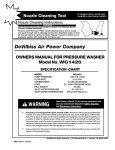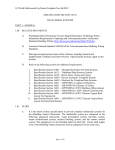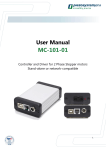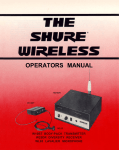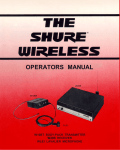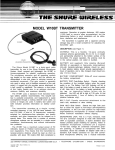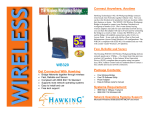Download ConnectGear WA300 User`s manual
Transcript
11Mbps Wireless Access Point (Color of this AP may vary with regions) User’s Manual Version 1.0 February 19, 2002 11Mbps Wireless Access Point User's Manual FCC Warning This equipment has been tested and found to comply with the limits for a Class B digital device, pursuant to part 15 of the FCC Rules. These limits are designed to provide reasonable protection against harmful interference in a residential installation. This equipment generates, uses and can radiate radio frequency energy and, if not installed and used in accordance with the instructions, may cause harmful interference to radio communications. However, there is no guarantee that interference will not occur in a particular installation. If this equipment does cause harmful interference to radio or television reception, which can be determined by turning the equipment off and on, the user is encouraged to try to correct the interference by one or more of the following measures: Reorient or relocate the receiving antenna. Increase the separation between the equipment and receiver. Connect the equipment into an outlet on a circuit different from that to which the receiver is connected. Consult the dealer or an experienced radio/TV technician for help. You are cautioned that changes or modifications not expressly approved by the party responsible for compliance could void your authority to operate the equipment. FCC Radiation Exposure Statement This equipment complies with FCC radiation exposure limits set forth for an uncontrolled environment and should be installed and operated with minimum distance 20cm between the radiator & your body. FCC ID: O6M-WA300 CE Marking Warning This is a Class B product. In a domestic environment this product may cause radio interference in which case the user may be required to take adequate measures. 2 11Mbps Wireless Access Point User's Manual Table of Contents 1. INTRODUCTION ....................................................................................................... 5 THE WIRELESS ACCESS POINT FEATURES ..................................................................................................... 5 PACKAGE CONTENTS....................................................................................................................................... 6 2.HARDWARE INSTALLATION ....................................................................... 7 PHYSICAL DETAILS .......................................................................................................................................... 7 HARDWARE INSTALLATION ............................................................................................................................. 9 CONNECTING THE ACCESS POINT TO YOUR NETWORK ................................................................................. 9 3. WIRELESS NAVIGATOR INSTALLATION .............................11 INSTALL TCP/IP PROTOCOL......................................................................................................................... 11 INSTALL THE WIRELESS NAVIGATOR ............................................................................................................ 14 STARTUP AND LOGIN ..................................................................................................................................... 17 4. CONFIGURING THE ACCESS POINT .......................................... 20 THE INFO TAB ................................................................................................................................................ 20 THE ASSOC TAB ............................................................................................................................................. 20 THE WIRELESS TAB....................................................................................................................................... 21 THE ADVANCED TAB ...................................................................................................................................... 22 THE SECURITY TAB ....................................................................................................................................... 23 THE IP ADDR TAB .......................................................................................................................................... 25 THE ADMIN TAB ............................................................................................................................................ 26 THE HELP TAB ............................................................................................................................................... 27 5. FIRMWARE UPGRADE PROCEDURE......................................... 28 6. FAQ & TROUBLESHOOTING ................................................................... 30 7. GLOSSARY .............................................................................................................................. 32 8. PRODUCT SPECIFICATIONS .................................................................... 34 3 11Mbps Wireless Access Point User's Manual About this manual This user’s manual describes how to install and operate the Wireless Access Point (AP). Please read this manual before you install the product. This manual includes the following topics: Product description, features and specifications Hardware installation procedures Software installation procedures Trouble shooting procedures 4 11Mbps Wireless Access Point User's Manual 1. Introduction Congratulations on your purchase of this 11Mbps Wireless Access Point (AP). This product is designed specifically for your 11Mbps wireless LAN environment needs. It is easy to configure and operate even for non-technical users. Instructions for installing and configuring this product are included in this manual. Before you install and use this product, please read the manual carefully so you may take full advantage of its functions. The Wireless Access Point Features LAN Features DHCP Client – Enable the AP to act as a DHCP client to receive IP address from DHCP Server in the wired Ethernet LAN. Built-in 10BaseT LAN Port – It’s designed to bridge between wired and wireless LAN. Wireless Features Standard Compliant – The AP complies with IEEE802.11b standard, and it is interoperable with IEEE802.11b-Compliant Equipment High Speed Wireless Connection – Using Diversity Dipole Antenna to secure reliable 11Mbps wireless data rate connection. Data Rate Auto Fall-Back - Provides 11, 5.5, 2 and 1Mbps wireless data rate shifting dynamically to guarantee availability and reliability of wireless connections Roaming – Provides seamless roaming within 802.11b wireless LAN infrastructure. Long Distance Reach – Support 80M indoor and 300M outdoors long operating distance under normal environment condition. Configuration & Management Easy to Setup – With windows-based Wireless Navigator Utility, user can easily setup the IP address of this AP, and upgrade the firmware. Easy to manage – User can use any WEB browser from anywhere on the wired or wireless LAN to configure the AP easily. Security Configuring Protection – Provides password protection to prevent unauthorized users from changing the configuration Wireless LAN Security - Provide 64-bit & 128-bit Wired Equivalent Privacy encryption to protect the wireless data transmissions. 5 11Mbps Wireless Access Point User's Manual Package Contents One 11Mbps Wireless Access Point One Dipole Antenna with Reversed SMA Connector One CD-ROM (Wireless Navigator utility software & user’s manual included) One RJ-45 straight LAN Cable One Power Adapter One Quick Installation Guide If any of the above items are damaged or missing, please contact your dealer immediately. 6 11Mbps Wireless Access Point User's Manual 2.Hardware Installation Physical Details Rear Panel Antenna Connection INIT Button LAN Cable LAN Connection Selection Switch Power Input Antenna Connection Please install the dipole antenna directly into the reversed SMA connector of AP. After AP start to work, you may adjust the angle of the antenna or reposition the AP to get a better performance and reach. INIT Button “INIT” mean “Initiation”. While pressing the button, the AP will reboot and reset current settings to factory default settings. The left indicator “DIAG” on AP will be off and then begin blinking. Then this initiation action will be completed when the indicator “ DIAG” is always green instead of blinking. LAN Cable Selection Switch Power Input X Crossover: the RJ-45 port Tx and Rx lines are reversed. Use this setting when you have a straight cable connected. It is also the factory default setting. II Straight: the RJ-45 port Tx and Rx lines are normal. Use this setting when you have a crossover cable connected. Only use the power adapter supplied with the Access Point 7 11Mbps Wireless Access Point User's Manual LAN Connection Use standard Ethernet cable (RJ-45 connector) to connect your PC, hub/switch or broadband router/modem to this port. LED Indications Power Diagnostic LAN Wireless LAN LED Power DIAG LAN WLAN Color Green Green Green Green Status Description ON The Access Point power on OFF The Access Point power off ON 1) The AP is in normal operation mode. 2) While in firmware upgrade process, it indicates the AP is writing the firmware into Flash ROM Blinking 1) The AP is in self-diagnostic mode. 2) While in firmware upgrade process, it indicates the AP is waiting the Wireless Navigator sending firmware image OFF 1) The AP starts to boot up the system. 2) While in firmware upgrade process, it indicates the firmware upgrade process is finished. ON The LAN port is linked Blinking The LAN port is sending or receiving data OFF No data forwarding between wireless and LAN ports. Blinking Sending or Receiving data via wireless 8 11Mbps Wireless Access Point User's Manual Hardware Installation Following illustration is an example showing how to install AP with hub/switch. Be sure to use the supplied power adapter. Connecting the Access Point to your Network For optimal performance, usually the center of your wireless network is the best place for your AP, with line of sight to all of your mobile stations. Try to place it in a position where can best cover your wireless network and is away from any potential source of interference. And normally, the higher you place the AP, the better the wireless signal coverage will be. 9 11Mbps Wireless Access Point User's Manual The following picture describes how to use the AP when communicating between wireless LAN and wired LAN. 10 11Mbps Wireless Access Point User's Manual 3. Wireless Navigator Installation Install TCP/IP Protocol TCP/IP Protocols are necessary for computers to communicate on LAN and Internet. Note! If your PC already has TCP/IP protocol installed, please skip this section. Please contact your administrator for details if you have problems of setting up this TCP/IP protocol in your PC. 1. From the Start Menu, select Settings and bring up the Control Panel. From the Control Panel, double-click on the Network icon. 11 11Mbps Wireless Access Point User's Manual 2. The screen shows the network components you have installed. Click the Add button to continue. 3. Highlight Protocol and click the Add button. 12 11Mbps Wireless Access Point User's Manual 4. Select Microsoft from the list of “Manufacturers” and TCP/IP from the list of “Network Protocols” and click the OK button to finish the installation. 13 11Mbps Wireless Access Point User's Manual Install the Wireless Navigator The Wireless Navigator Utility is provided to allow user(s) easily to configure the AP through any Windows-based PC over wired or wireless LAN port. This section describes procedures for installing the Wireless Navigator Utility to PC. Step 1: Insert the installation CD-ROM into the CD-ROM drive. Run SETUP.EXE program on the CD-ROM. The following window will be shown automatically. Step 2: After InstallShield Wizard preparation finished, the following window will be shown. Click the Next button to continue. 14 11Mbps Wireless Access Point User's Manual Step 3: Key in your User Name and Company Name, and click Next button to continue. Step 4: The screen will show you the default destination chosen by the utility. If you want to install the Wireless Navigator in another location, click the Browse button and select an alternate destination. Click the Next button, when you are ready to continue. The setup program will then begin to install the programs into the destination folder. 15 11Mbps Wireless Access Point User's Manual Step 5: The screen will show you the Program Folder that the utility will use. You may type a new folder name to create a new program folder, or select one from the existing folder list, and click Next button to continue. Step 6: The Wireless Navigator has been installed now. Please click the Finish button to complete installation. Note: To remove Wireless Navigator Utility, click the Start button, and select Programs, Wireless Navigator, and Uninstall, and then follow the instruction on screen. 16 11Mbps Wireless Access Point User's Manual Startup and Login Follow the procedures below to startup Wireless Navigator and find the AP. Before you start the following procedures, please be sure to connect the Ethernet cable, connect the power cord, and then turn on the AP. All wireless clients shall be requested to set the their SSIDs same as the AP SSID in advance before starting the following procedures. 1. Refer to previous section " Install the Wireless Navigator to your PC" in order to startup the configuration. 2. Click Start and select Programs, Wireless Navigator and then Wireless Navigator. Or, just double-click the Wireless Navigator icon on your desktop screen. 3. The Wireless Navigator starts up, and search via wired LAN or Wireless LAN (depend. 17 11Mbps Wireless Access Point User's Manual 4. The utility will show the AP and other wireless devices found in the same network, where your PC is located. Note! If the AP is not shown in the list, please make sure all the cables are well connected. 5. Double-click on the AP, then you will access into its built-in web server, and it will show as below. Then directly click OK button. (Default setting is no user name and password needed). Note! If you cannot access into AP’s built-in web server, please make sure if your PC now is in the same subnet with AP. Please us right-click of mouse to click on the AP listed in Wireless Navigator. “Set IP address” option will pop out, and then change IP address of AP to the same subnet as your PC. 18 11Mbps Wireless Access Point User's Manual 6. Then following screen will be shown. Now you have entered the built-in web server of this AP, and you can start to configuration procedures. 19 11Mbps Wireless Access Point User's Manual 4. Configuring the Access Point The Info Tab INFORMATION: displays the basic information of this AP. Firmware revision: displays current firmware version of this AP. MAC address of AP: displays the unique serial number burned into this AP that identifies itself from other Ethernet devices Current IP address: displays current IP address of this AP. The Assoc Tab ASSOCIATIONS: displays all the wireless clients, which are currently associated with this AP. Mac address: displays the MAC address of associated wireless client. Time idle: displays the idle time of each associated wireless client 20 11Mbps Wireless Access Point User's Manual The Wireless Tab Wireless: displays the basic wireless configuration of this AP. Access point name: displays current device name of the AP. You also can change the name as your will. SSID: Used to identify the wireless LAN. To communicate with this AP, all wireless clients MUST use the same SSID as AP’s. The SSID is case sensitive. Default SSID is “Wireless”. Channel: Selects the appropriate radio channel from the list provided. The permissible number of channels depends on the Regulatory Domain. (The factory default channel setting also depends on the Regulatory Domain). Basic rates (Mbits/s): The transfer rate that is used when a client is to associate with the AP. Supported rates (Mbits/s): The transfer rate that a client is capable of receiving. Transmission Rate: Selects the rate adapting mechanism. The default setting is “Automatic”, which allows the AP to automatically adjust its transfer speed for optimal performance and longest operating range. Preamble type: Uses long, short or both preambles in physical layer. Default value is “Long”. Note! You may need to re-load the page to see any new settings. 21 11Mbps Wireless Access Point User's Manual The Advanced Tab ADVANCED: displays the advanced wireless configuration of this AP. Max associated stations: displays the maximum number of associated clients. In order to get a better performance, it is suggested to set “8” as the maximum number of associated clients to get a balanced performance Exclude long preamble: Enables to exclude packets with long preambles in physical layer. Fragmentation threshold: The threshold which a data packet will be fragmented. RTS threshold: The threshold which a RTS packet will be sent before a data packet is sent. Beacon period: The period in millisecond a beacon will be sent. DTIM interval: Number of beacon intervals between successive DTIM (Delivery Traffic Identification Maps). Multicast PM buffering: Enables the data buffering for Power Management. Note! You may need to re-load the page to see any new settings. 22 11Mbps Wireless Access Point User's Manual The Security Tab SECURITY: displays the 802.11b security and encryption options on this AP. Hide SSID in Beacon: The option to hide the SSID in beacon, so that this AP will not be found by a passive scan from Wireless Navigator Stations cannot use “unspecified” SSID: Enables the AP to NOT associate with any station whose SSID is set as “Any”. 23 11Mbps Wireless Access Point User's Manual WEP configuration: Display the Wired Equivalent Privacy security configurations WEP enabled: Enables the Wired Equivalent Privacy security function. WEP key length: Selects 64-bit or 128-bit WEP encryption. Be sure that the setting in the AP shall be the same as in wireless clients, otherwise the communication will not work. WEP key: For 64-bit WEP encryption, a key of 10 hexadecimal characters in length must be filled in. For 128-bit WEP encryption, a key of 26 hexadecimal characters in length must be filled in.. Be sure that the keyin the AP shall be the same as in wireless clients, otherwise the communication will not work. WEP key to use: Selects one of four key sets to be used for encryption. To connect to a Wi-Fi compliant wireless device, key #1 must be selected. Deny unencrypted data: Checks this box, then any unencrypted data frames will be denied. Authentication: Selects the mechanism of shared key, open system or both authentication algorithm MAC address filtering: Displays the MAC address filtering mechanism. Enable filtering: Enables to filter the MAC address of every wireless device, which intends to associate with this AP. Add an address: Adds an MAC address of a wireless device to the filter list. Addresses to allow: Adds MAC addresses of those wireless devices, which are allowed to associated with the AP. Note! How to get the MAC address: For example, If your PC is running in Windows environment, please enter the DOS Box, and key in the command “ ipconfig /all ” to get the Physical Address (MAC address) of your PC. For users who use other operation systems, please consult the system administrator for details. Note! You may need to re-load the page to see any new settings. 24 11Mbps Wireless Access Point User's Manual The IP Addr Tab IP ADDR: displays the status of current IP setting . IP Address Mode: Select “Static” or “DHCP” mode. For “Static” mode, the IP address settings are given by user. For “DHCP” mode, these settings will be overridden by a DHCP server on your network. The default setting is “Static” IP Address: The static IP address you want to assign to the AP. The default value is “192.168.1.100”. IP Subnet: The subnet mask you want to assign for the AP. The default value is “255.255.255.0”. IP Gateway: The gateway you want to assign for the AP. The default value is “192.168.1.1”. Allow upgrade uploads: Check the box, and then it is allowed to upgrade firmware. Note! You may need to re-load the page to see any new settings. 25 11Mbps Wireless Access Point User's Manual The Admin Tab ADMINISTRATION: Allows to change the device’s system configurations. Change password: Default none password. Reboot access point: When any setting was changed, the AP MUST be reboot so that the change can be confirmed. Reset to factory defaults: This option will ERASE all the current settings, and return back to the factory defaults. Note! There could be several PCs over wired or wireless LAN installing with Wireless Navigator Utility, and managing the AP simultaneously. Hence, it is suggested to change the password. Note! You may need to re-load the page to see any new settings. 26 11Mbps Wireless Access Point User's Manual The Help Tab HELP: Displays the explanations of each setting shown in above seven tabs. Please click those hyperlinks in right side, and then it will show you to the meaning of each setting. 27 11Mbps Wireless Access Point User's Manual 5. Firmware Upgrade Procedure 1. Click Start and select Programs, Wireless Navigator and then Wireless Navigator. Or, just double-click the Wireless Navigator icon on your desktop screen. 2. The Wireless Navigator starts up. 3. The computer starts searching for the Access Point and shows in the list. Choose the AP that you would like to upgrade the firmware, and use the right-click of the mouse to enter the “Upgrade FW” option 28 11Mbps Wireless Access Point User's Manual 4. The download will begin. Key in the new firmware file name and location or click browsing to find the file in your computer. 5. After entering the file information, click OK to continue. 6. The downloading begins. 7. After download finished, the AP will reset automatically, and the left indicator “DIAG” on AP will be off and then begin flashing. When the indicator “ DIAG” is always green instead of blinking, the firmware upgrade is completed and successfully. 29 11Mbps Wireless Access Point User's Manual 6. FAQ & Troubleshooting This chapter provides solutions to problems usually encountered during the installation and operation of the Wireless Access Point. Please refer to the following descriptions to solve the problems. If you can’t find an answer here, please contact your dealer for further advices. Q: My PC can’t locate the Wireless Access Point. How to check the problem? A: Please follow the procedures below: Check if your PC has installed TCP/IP protocol. Check if the IP addresses of your PC and Wireless Access Point both are on the same IP network. If not, you may use Wireless Navigator to set up AP’s IP address, or change your PC’s IP address. Check if your wireless LAN card is set to Infrastructure correctly. Check if the SSID of your wireless card is the same as AP’s. Check if the WEP is enabled. If yes, please make sure that the wireless card in your PC and the Wireless Access Point both have the same setting for WEP, such as the key tables must match. At last, please check if radio interference is causing a problem; see if connection is possible when close to the Wireless Access Point. Remember that the connection range can be as short as 100 feet in poor environment. Q: The Wireless connection speed is very slow. How to improve the problem? A: The wireless system will connect at the highest possible speed, depending on the distance and the environment condition. To obtain the highest possible connection speed, you have to try to adjust the Access Point location and orientation. If you find the interference is the problem, changing to another channel may show a marked improvement. Q: Can I run an application from a remote computer over the wireless network? A: This will depend on whether or not the application is designed to be used over a network. Consult the application’s user guide to determine if it supports operation over a network. Q: Can I play computer games with other members of the wireless network? A: Yes, as long as the game supports multiple players over a LAN (local area network). Refer to the game’s user guide for more information. 30 11Mbps Wireless Access Point User's Manual Q: What is the IEEE 802.11b standard? A: The IEEE 802.11b Wireless LAN standards subcommittee, which is formulating a standard for the industry. The objective is to enable wireless LAN hardware from different manufacturers to communicate. Q: What’s Ad-hoc? A: An Ad-hoc wireless LAN is a group of computers, each with a WLAN adapter, connected as an independent wireless LAN. Ad-hoc wireless LAN is applicable at a departmental scale for a branch or SOHO operation. Q: What is Infrastructure? A: An integrated wireless and wired LAN is called an Infrastructure configuration. Infrastructure is applicable to enterprise scale for wireless access to central database, or wireless application for mobile workers. Q: What is Roaming? A: Roaming is the ability of a portable computer user to communicate continuously while moving freely throughout an area greater than that covered by a single Wireless Network Access Point. Before using the roaming function, the workstation must make sure that it is the same SSID with the Wireless Access Point of dedicated coverage area. Q: What is Spread Spectrum? A: Spread Spectrum technology is a wideband radio frequency technique developed by the military for use in reliable, secure, mission-critical communications systems. It is designed to trade off bandwidth efficiency for reliability, integrity, and security. In the other words, more bandwidth is consumed than in the case of narrowband transmission, but the trade off produces a signal that is, in effect, louder and thus easier to detect, provided that the receiver knows the parameters of the spread-spectrum signal being broadcast. If a receiver is not turned to the right frequency, a spread-spectrum signal looks like background noise. There are two main alternatives, Direct Sequence Spread Spectrum (DSSS) and Frequency Hopping Spread Spectrum (FHSS). Q: What is WEP? A: WEP is Wired Equivalent Privacy, a data privacy mechanism based on a 64-bit or 128-bit as described in the IEEE 802.11 standard. 31 11Mbps Wireless Access Point User's Manual 7. Glossary This section explains the glossary of terms used in this manual that are required to configure the network. Wireless Channel If there is more than one Wireless LAN network with different ESS-ID on the same floor, and they are communicating with each other, the baud rate may be slowed, due to the same radio frequency being used. If this happens, you can still communicate regardless of other LAN networks by using to use different frequencies (wireless channels). Note: If they are communications using the wireless LAN, be sure to set all the Units the same wireless channel. DHCP Server When configuring the network TCP/IP, be sure to set the IP address in each personal computer and other devices. When there is a DHCP server on the network, you can assign IP addresses automatically to the personal computers and the Access Point on the network. For the Windows NT server and dial-up router, or other DHCP server function, refer to the Windows 2000, Windows NT, or dial-up router manual, or consult the manufacturer. ESS-ID This ID is used to prevent cross-communication during communication between the Access Point and personal computers within the wireless LAN. The Wireless LAN personal computers that have the same ESS-ID as the Access Point can communicate with the Access Point. The ESS-ID is case sensitive. You can enter a maximum of 32 alphanumeric characters, and the underline "_". LAN (Local Area Network) Read as one word. A LAN is a network in a comparatively small area, such as campus or within a single building. The LAN baud rate varies from 10 Mbps to 100 Mbps. MAC Address (Media Access Control Address) The MAC address is a physical address specific to each network card. The MAC address is configured from a total of six bytes as follows: A vendor code comprising the lead three bytes and a 3-byte user code. The vendor code is managed and assigned by IEEE. The user code is managed using a unique (unduplicated) number from the network card manufacturer. That is, the MAC address is assigned as a physical address unique 32 11Mbps Wireless Access Point User's Manual throughout the world. In an Ethernet LAN, the MAC address is used as a base to create a frame for sending and receiving. TCP/IP (Transmission Control Protocol/Internet Protocol) TCP/IP is a protocol equivalent to the network and transport levels of the OSI reference model, and it is defined using RFC. Consequently, different terminals can communicate with each other using TCP/IP. • Normally, TCP/IP includes the application protocols TELNET and FTP. • TCP/IP is the standard Internet protocol. WEP (Encryption) By setting an encryption key in the Access Point, you can prevent wireless packets from being decrypted externally. Firmware Firmware is the name given to the software (programs) built into hardware such as the router, modem, and terminal adapter. This software is built into the hardware, so it can be said to be in-between hardware and software. Protocol Protocols are the procedures and regulations for sending and receiving data between the network terminals. For example, if two computers are communicating, you can send the correct information according to the regulations by formatting all required information. The protocol such as which terminal sends first, what type of message, what type of message the receiving terminal should send in reply, the data format, and responses to communications errors are same of examples. Roaming Function Using the roaming function and moving from one room to another room, you can switch the Access Point automatically. With the roaming function, you can easily move from the office to the conference room while maintaining access to the network. 33 11Mbps Wireless Access Point User's Manual 8. Product Specifications This chapter describes the specifications of the product and the LAN port connector. Wireless LAN Interface Standards IEEE 802.11/11b Compliant Antenna Single Dipole Antenna (with reversed SMA connector) Frequency Range 2.4∼2.4835GHz ( Industrial Scientific Medical Band ) DSSS - Direct Sequence Spread Spectrum Data Transmission Rate 11Mbps / 5.5Mbps / 2Mbps / 1Mbps Auto Fall-Back Access Mode Infrastructure mode Data Security Provides both 64-bit & 128-bit WEP Encryption Output Power 15 ~16.5 dBm Receiving Sensitivity -82dBm Min. Roaming IEEE 802.11 Compliant Channels 11 Channels (US, Canada) 13 Channels (Europe) 34 11Mbps Wireless Access Point User's Manual Coverage Area Indoors: up to 50M (165 ft.) @11Mbps up to 80M (265 ft.) @5.5 Mbps or lower Outdoors: up to 150M (500 ft.) @11 Mbps up to 300M (1000 ft.) @5.5 Mbps or lower (Depending on environment) Operating Environment Operating Temperature: 0oC to 50oC degree Storage Temperature: –25oC to 70oC degree Humidity 10% to 90% non-condensing 35





































